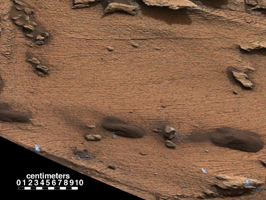
Figure 1
Click on the image for larger versionThis image shows an example of a thin-laminated, evenly stratified rock type that occurs in the "Pahrump Hills" outcrop at the base of Mount Sharp on Mars. The Mast Camera (Mastcam) on NASA's Curiosity Mars rover acquired this view during the 792nd Martian day, or sol, of the rover's work on Mars (Oct. 28, 2014). The area of rock surface shown is about 3 feet (1 meter) across.
This rock type underlies a more thickly laminated, even-bedded rock type seen in PIA19074. The thinner scale of sedimentation suggests deposition farther from a source of delta-building sediment, possibly in deeper lake water, so that sedimentation events formed thinner laminations. The light color of the outcrop reflects a layer of dust.
The color has been approximately white-balanced to resemble how the scene would appear under daytime lighting conditions on Earth. Figure 1 is a cropped version with a superimposed scale bar of 10 centimeters (about 4 inches).
The image was taken with Mastcam's left-eye camera partway through a drive on that sol between the "Alexander Hills" and "Chinle" target areas. The locations of Alexander Hills and Chinle within the Pahrump Hills outcrop at the base of Mount Sharp are indicated on an earlier Mastcam view at PIA19039.
NASA's Jet Propulsion Laboratory, a division of the California Institute of Technology, Pasadena, manages the Mars Science Laboratory Project for NASA's Science Mission Directorate, Washington. JPL designed and built the project's Curiosity rover. Malin Space Science Systems, San Diego, built and operates the rover's Mastcam.
More information about Curiosity is online at http://www.nasa.gov/msl and http://mars.jpl.nasa.gov/msl/.

